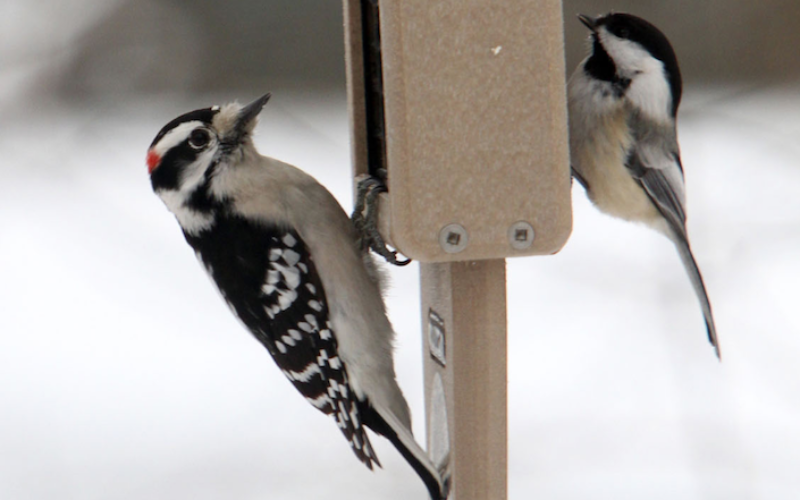Maintaining feeders, houses must be part of promise
AMANDA BANCROFT
Making Ripples
This sentence might be your first encounter with the knowledge that uncleaned nest boxes, suet cages, bird feeders, nectar feeders and bird baths create dead birds. But don’t despair! The choice to maintain these offerings is still yours, and if you can’t maintain them, you can get help or take them down instead of taking down birds. Knowledge is power, right?
Spring is perhaps the most delightful time to watch birds because they’re nesting. Songbirds, owls, woodpeckers and more are busy feeding nestlings or fledglings, which are cute to see in our yards. However, if old nesting material has built up in your nest box — which most likely can’t even be opened because it was designed to be ornamental — this makes it easier for predators to reach in and grab eggs or nestlings. It also creates a breeding ground for bird diseases and insects that eat nestlings.
You may have to modify the box to allow it to easily open. Or build or buy the correct kind of nest box. Remove old nesting material far away from the nest site so that predators don’t find the nest. Get a scraping tool and scratch crusty gunk off the walls and floor of these boxes at least once in late winter. Some readers might have trouble knowing if the nesting material is old or new. Old nests will be flattened and contain fecal sacks or debris.
Consider whether you care more about birds or seeing an ornamental bird house. If it’s the latter, please don’t put up an unmaintained nest box unless you plug the hole or put a cute decorative bird on it to block the opening.
Mid-March is a great time to put out those hummingbird feeders for early spring migrants. The ruby-throated hummingbirds will appreciate the nectar after their exhausting journey north! But to lend them a helping wing, don’t use artificial red food coloring. A red feeder or a yard with nectar from native flowers will attract the hummers to your feeders without the dye in the sugar water. If possible, keep feeders out of direct sunlight so that the sugar water doesn’t spoil as quickly. According to the Hummingbird Society, we should wash our hummingbird feeders every five days or more frequently if we notice mold growth, a cloudy appearance to the water, or if the temperature is 90 degrees or hotter outside. Offer cane sugar or any type of sugar without molasses (don’t use turbinado, for example). Molasses is toxic to hummingbirds because of its iron content.
Seed feeders can really help birds and provide hours of entertainment for humans and indoor cats alike. Never cleaning them can result in sick or dead birds. You haven’t seen dead birds at your unclean feeder because they can’t fly once they’re dead. (This point seems obvious, but some people naturally flock towards denial). Clean seed feeders once a week or as needed, but at least four times a year and immediately if you notice sick birds. Some feeders are much easier to clean than others, so if you’re disinclined to clean yours, one option may be to switch feeder types.
Safely position feeders. The Cornell Lab of Ornithology explains that there are safe distances at which to install feeders. “Perhaps counterintuitively, feeders are safest when they’re closest to windows — because if a bird takes off from the feeder and hits the window, it won’t be going at top speed and has a better chance of surviving. Place feeders closer than 3 feet to a picture window (or even affixed to the glass or window frame), or farther than 30 feet from a window.” If you aren’t going to spend years becoming an ornithologist and measuring bird deaths from window collisions in order to refute their claim, just take their word for it and keep your feeders at safe distances.
Suet feeders are great, but if it starts to melt in summer or is offered in a way that gets fatty oils onto a bird’s feathers (such as peanut butter smeared onto a log) this prevents the bird from being able to thermoregulate and fly. Bird saliva and rain won’t clean off the oil; just like with an oil spill, slicked-up bird feathers require soap or a solvent to remove the suet oil. Take down suet feeders if they’re melting, clean the cages, and don’t offer suet on a trunk or surface that the birds will have to brush up against.
Bird baths should be maintained to prevent mosquito bites as well as disease that affects all the wildlife drinking from the bath. Try to clean it at least a couple of times a week by emptying the water, scrubbing the bottom, and refilling.
Feeding birds is actually a big responsibility. It’s tempting to deny science when it recommends we do more work, but remember the choice is always ours: Offer wildlife safe nesting boxes and feeders, or don’t offer them anything. Scientists aren’t lying to you about bird health just to ruin your Saturday afternoon with more chores. They want to save wildlife, and we can help by accepting and correcting our mistakes.
Amanda Bancroft is a writer, artist, and naturalist living in an off-grid tiny house on Kessler Mountain. She and her husband Ryan blog about their adventures and offer tips to those wanting to make a difference at www.RipplesBlog.org.










